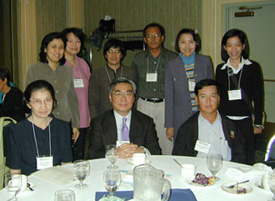News & Announcements
The IIRP’s SaferSanerSchools program has grown considerably since its initial pilot projects. The program is helping schools implement restorative practices, an approach that engages students to take responsibility for their behavior, thereby building school community and safety.
SaferSanerSchools is working with schools all over the world. An eForum article about its role with Community Prep High School, a New York City public school for students just out of juvenile detention, as reported in The New York Times, can be found here.
Below are accounts of a few of the many schools using circles, “restorative questions” (What were you thinking about at the time? Who did you affect by your actions, and how? What do you need to do to make things right?) and other practices to build a restorative school culture. Administrators and teachers are developing lots of creative ways to implement the approach.
Brookside Youth Centre, in Cobourg, Ontario, Canada, about 70 kilometers east of Toronto, is a secure residential facility and secondary school for young men who have come into conflict with the law, capacity 106. Brookside is using the Real Justice (an IIRP program) model of restorative justice conferencing. Below are excerpts from an interview with Brookside staff members Michael Maguire, superintendent of administration and programs; Bruce Schenk, chaplain and co-coordinator of the restorative justice program; and Ron Cameron, principal of the secondary school. The interview was conducted at “Building a Global Alliance for Restorative Practices and Family Empowerment, Part Two,” the IIRP's Fifth International Conference on Conferencing, Circles and Other Restorative Practices, August 2004, in Vancouver, British Columbia, Canada, where the men appeared as presenters.
(A letter from Community Prep co-leaders Ana Bermúdez and Mark Ryan is available here.)
The International Institute for Restorative Practices (IIRP), via its SaferSanerSchools program, is providing training and consulting at Community Prep High School, a public school in New York City for young people just out of juvenile detention. These are the kind of kids who are typically stigmatized as "tough" or "incorrigible" and written off. The story of how the IIRP and Community Prep's staff collaborated to implement restorative practices at this remarkable school was reported in The New York Times.
"Each year, as many as 8,000 New York City students, ages 13 to 18, return to their neighborhoods from juvenile detention centers and placement facilities … after serving time for offenses ranging from assault to drug possession. … An overwhelming majority are black or Hispanic, and poor. They have low reading scores, records of truancy and disruptive behavior and few credits toward graduation. About half have been labeled as needing special education. Many have no parents at home," wrote Sara Rimer, in her article, "Last Chance High," The New York Times, July 25, 2004. "But just at this crucial moment, many high schools, reluctant to take on what they perceive as difficult students, turn them away."
The IIRP's fifth international conference, "Building a Global Alliance for Restorative Practices and Family Empowerment, Part 2," in Vancouver, British Columbia, Canada, was a tremendous success, thanks to the many dedicated participants who journeyed from far and wide to contribute their wisdom and experience to the event. A delegation from the Thailand Ministry of Justice, including Kittapong Kittayarak, director general of the Department of Probation (seated middle), and Wanchai Roujanavong, director general of the Department of Juvenile Observation and Protection (seated right)
A delegation from the Thailand Ministry of Justice, including Kittapong Kittayarak, director general of the Department of Probation (seated middle), and Wanchai Roujanavong, director general of the Department of Juvenile Observation and Protection (seated right)
Attendees came from such countries as Australia, Belgium, China, England, Hungary, Ireland, Japan, the Netherlands, Scotland, South Africa, Spain, Sweden, Thailand; seven provinces and two territories of Canada; and 26 states and the District of Columbia in the United States. There were representatives of such First Nations and Native American nations as the Akwesasne, Aleut, Champagne and Aishihik, Couchiching, Flying Dust, Heiltsuk, Inuvik, Kahnawake, Liard, Mi'kmaw, Ojibway, Peguis and Wet'suwet'en.
Rob van Pagée, of Eigen Kracht Centrale and Op Kleine Schaal, in the Netherlands, organizations that provide family group decision making (FGDM) and Real Justice conferencing throughout Europe, argues for widespread use of both conferencing models as a means to empower citizens and reinvigorate democracy. The paper was presented at the second in a series of three IIRP conferences with the theme, "Building a Global Alliance for Restorative Practices and Family Empowerment," in Vancouver, Canada, August 5-7, 2004.
This paper, by Thom Allena, managing partner, Innovations in Justice, Taos, New Mexico, and Mark Seidler, organizational change consultant, Hampton Bays, New York, explains the rationale behind their special interactive plenary session. Participants met in small groups to obtain a sense of the connections between the many programs and research activities in the field of restorative practices. The paper was presented at the second in a series of three IIRP conferences with the theme, "Building a Global Alliance for Restorative Practices and Family Empowerment," in Vancouver, Canada, August 5-7, 2004.
Rick Hugh, vice principal, Clayton Heights Secondary School, and Jenni Lynnea, counselor, Princess Margaret Secondary School, discuss how restorative practices have been effectively utilized in their large, multicultural district in the Greater Vancouver area. The paper was presented at the second in a series of three IIRP conferences with the theme, "Building a Global Alliance for Restorative Practices and Family Empowerment," in Vancouver, Canada, August 5-7, 2004.
Ted Wachtel, president of the International Institute for Restorative Practices, explains how restorative justice principles have extended beyond criminal justice into the emerging field of restorative practices, which offers a common thread to tie together research and practice in seemingly disparate fields. The paper was presented at the second in a series of three IIRP conferences with the theme, "Building a Global Alliance for Restorative Practices and Family Empowerment," in Vancouver, Canada, August 5-7, 2004.
“A Survey of Assessment Research on Mediation and Restorative Justice,” by International Institute for Restorative Practices director of research Paul McCold, has been published as a chapter in the book Repositioning Restorative Justice: Restorative Justice, Criminal Justice and Social Context. The paper provides an overview of 30 years of evaluation research of restorative justice programs from 1971 to 2001. The survey is limited to program assessments available in English and is representative of mediation and conferencing programs that have conducted and published the results of those assessments. Paul McCold Director of Research, IIRP
Paul McCold Director of Research, IIRP
Said McCold, “This is one of a series of very informative articles published as a result of the Fifth Conference of the International Network for Research on Restorative Justice [held September 2001] and available from Willan Publishing [in Devon, England].” The book can be ordered through the website for Willan Publishing: http://www.willanpublishing.co.uk/reposrj.html.
Part two of this series includes interviews with Louise Thompson, of the Mohawk Nation of Akwesasne, and Leanne Douglas, Christine Douglas and Stephanie Sandy of the Mnjikaning First Nation.
